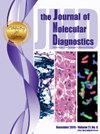Impact and Reproducibility of In-House Targeted Next-Generation Sequencing Biomarker Testing in Non–Small-Cell Lung Cancer
IF 3.4
3区 医学
Q1 PATHOLOGY
引用次数: 0
Abstract
Next-generation sequencing (NGS) allows the detection of multiple genetic targets in different tumor types. This study aimed to confirm the benefits of implementing in-house NGS testing for non–small-cell lung cancer (NSCLC) samples in molecular pathology laboratories. A multi-institutional study was conducted to evaluate the analytical performance, turnaround time, and feasibility of in-house NGS testing of 50 genes from 283 NSCLC samples. The first phase was a retrospective study with interlaboratory testing (21 samples), and the second phase was a prospective study with intralaboratory testing (262 samples). The retrospective study showed a 100% sequencing success rate for DNA and RNA, high interlaboratory concordance (95.2%), and a strong correlation (R2 = 0.94) between observed and expected single-nucleotide variant/insertion and/or deletion variant allele fraction. The prospective study showed a sequencing success rate of 99.2% for DNA and 98% for RNA. NGS identified 285 relevant variants (81.1% single-nucleotide variants/insertion and/or deletion variants, 9.8% copy number variants, and 9.1% gene fusions). Co-mutations with potential clinical relevance were detected in 20.5% of samples positive for the main oncogenic drivers in NSCLC. Additionally, 11% of samples wild type for the main oncogenic drivers carried alterations in other relevant genes. The in-house NGS testing had a median turnaround time from sample processing to molecular report of 4 days. This study demonstrates the advantages of implementing in-house NGS testing in molecular pathology laboratories.
非小细胞肺癌内部靶向下一代测序生物标志物检测的影响和可重复性:意大利多机构经验。
新一代测序(NGS)可以检测不同肿瘤类型中的多个基因靶点。本研究旨在证实在分子病理学实验室对非小细胞肺癌(NSCLC)样本实施NGS检测的益处。一项多机构研究对283份NSCLC样本中50个基因的内部NGS检测的分析性能、周转时间和可行性进行了评估。第一阶段是回顾性研究,实验室间测试(21个样本),第二阶段是前瞻性研究,实验室内测试(262个样本)。回顾性研究显示,DNA和RNA的测序成功率为100%,实验室间一致性高(95.2%),观察到的SNV/indel等位基因分数与预期的SNV/indel等位基因分数有很强的相关性(R2 = 0.94)。这项前瞻性研究显示,DNA和RNA的测序成功率分别为99.2%和98%。NGS鉴定出285个相关变异(81.1% SNV/indel, 9.8% CNV和9.1%基因融合)。在非小细胞肺癌的主要致癌驱动因子阳性样本中,有20.5%检测到具有潜在临床相关性的共突变。此外,11%的主要致癌驱动因子野生型样本在其他相关基因的改变上呈阳性。内部NGS的经验表明,从样品处理到分子报告的平均周转时间为4天。总之,本研究证明了在分子病理学实验室实施内部NGS检测的优势。
本文章由计算机程序翻译,如有差异,请以英文原文为准。
求助全文
约1分钟内获得全文
求助全文
来源期刊
CiteScore
8.10
自引率
2.40%
发文量
143
审稿时长
43 days
期刊介绍:
The Journal of Molecular Diagnostics, the official publication of the Association for Molecular Pathology (AMP), co-owned by the American Society for Investigative Pathology (ASIP), seeks to publish high quality original papers on scientific advances in the translation and validation of molecular discoveries in medicine into the clinical diagnostic setting, and the description and application of technological advances in the field of molecular diagnostic medicine. The editors welcome for review articles that contain: novel discoveries or clinicopathologic correlations including studies in oncology, infectious diseases, inherited diseases, predisposition to disease, clinical informatics, or the description of polymorphisms linked to disease states or normal variations; the application of diagnostic methodologies in clinical trials; or the development of new or improved molecular methods which may be applied to diagnosis or monitoring of disease or disease predisposition.

 求助内容:
求助内容: 应助结果提醒方式:
应助结果提醒方式:


